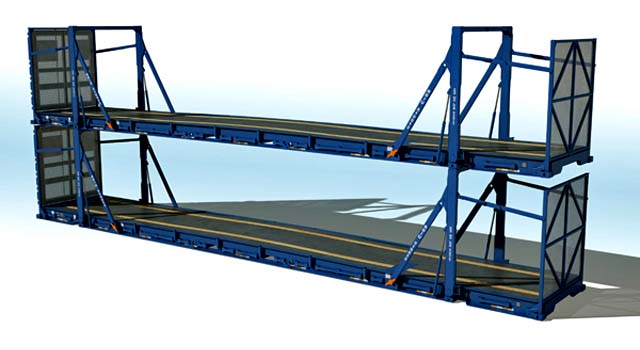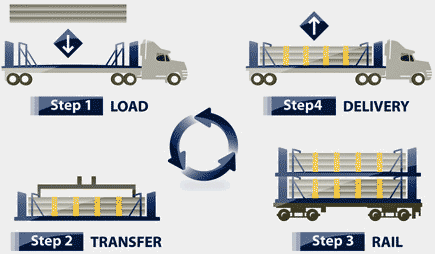
2011
|


Stacked Raildecks.
17 October 2011
Efficient New Rail Product Creates Intermodal Opportunities
Toronto Ontario - Canadian Pacific will be the exclusive Canadian rail transportation provider for Contrans, using innovative Raildecks
multimodal flat rack containers. The agreement extends the long-haul efficiencies of rail to markets currently served by transport trucks across Canada.

"Raildecks' innovative product extends the efficiencies of intermodal rail to industrial products shippers," said John McBoyle, Vice-President
Intermodal at Canadian Pacific. "We believe industrial product customers will be attracted to the consistency, efficiency, and reliability of our
long-haul intermodal network."
"The Raildecks solution provides a viable option to convert some of the industrial freight that is moving over the road to be transported on intermodal
rail," said Rick Jocson, CEO of Raildecks. "By converting a traditional over-the-road commodity to rail, Raildecks are reducing greenhouse gas
emissions, freeing up major roads and highways, and reducing costs for shippers."
"We are excited to be able to provide shippers with a brand new service offering," stated Stan G. Dunford, Contrans' Chairman and Chief Executive
Officer. "This will revolutionize the long haul flatbed market and will result in substantial efficiencies and savings for shippers."
Canadian Pacific has been testing Raildecks' 53 foot collapsible, multi-modal carriers over the summer at its Toronto Intermodal Facility in Vaughn, Ontario.
The testing proved the concept, as pipe and other industrial products moved seamlessly on CP's longhaul intermodal trains. Previously shippers relied on trucks
to move these types of products over a long distance.
About Contrans
Contrans is a leader in the Canadian transportation industry and has been providing exemplary service to its customers since 1926. With the widest array of
trailer configurations available for shippers, Contrans is Canada's most diversified transportation company.
About Raildecks
Raildecks is a North American company that has developed innovative transportation solutions by creating the industry's first 53 foot open top intermodal flat
rack for double stack transportation. The equipment has been designed to convert traditional over the road industrial freight onto the high speed intermodal
rail network. As an open container with no ceiling or side walls the Raildecks container can be collapsed for cost effective repositioning and storage. This
road-to-rail conversion reduces greenhouse gas emissions, frees up major roadways and highways, adds capacity and reduces cost. Raildecks is an active member
of The Intermodal Association of North America (IANA) a qualified member of the AAR. Visit www.railDecks.com to
learn more about our innovative open-top intermodal solutions.
Backgrounder Raildecks Intermodal
Raildecks Intermodal is a North American company that has developed the industry's first 53 foot open top intermodal container for double stack
transportation.
Raildecks Intermodal has spent considerable resources to develop a double stack intermodal container solution that is light enough to compete with existing
over-the-road flatbed trailers yet durable and strong enough to meet the safety needs of the rail industry. Before launching the commercial model of the
container, Raildecks Intermodal tested model 5.1 design at the Association of American Railroads (AAR) test facility in Pueblo, Colorado. Following the
successful testing of the initial prototype decks in Pueblo, a field trial program was initiated with the BNSF Railway and Boyd Brothers Transportation.
The field trial program was launched in June of 2010 with the BNSF Railway providing the intermodal rail expertise, Boyd Brothers providing the traditional
flatbed expertise, and Raildecks Intermodal as the coordinator of the equipment and service. Initially there were only a few markets that were open to the
trial program, and only select drivers, commodities, and shippers could participate. The start of the program was highly monitored to ensure that best industry
practices were being followed. Load diagrams were prepared in advance and shared with all the field trial partners. Lading chalk lines were drawn on the deck
prior to in-gating at the intermodal rail terminal to measure the movement when it arrived at the destination terminal. The first 60 loads were documented from
the time the Raildeck container was loaded at the consignor to the time it was unloaded at its' destination. Based on the success of the first sixty loads, the
program has expanded to all of the intermodal terminals on the BNSF system. In addition, test loads have moved on the Norfolk Southern and the Union Pacific
network. As of today, the Raildeck container has moved over 230 loads without any incident. The use of the Raildecks container solution in the US has reduced
an estimated 1,425 tons of CO2 emission by moving over 15 different commodities over a total of 335,409 miles. Recently, the Canadian program was launched with
Canadian Pacific as the rail partner and the Contrans Flatbed Group as the motor-carrier partner.
The data captured during the field trial was analyzed by Raildecks Intermodal engineers and used in the design of the commercial model. The result is a new 6.1
model Raildecks container that is lighter and stronger than the previous version. In addition, the new model has fewer moving parts and no removable main
parts, thus reducing the total cost of ownership. The final product uses an aluminum deck surface that is mounted to a steel sub-frame structure. The process
to mount dissimilar metals is a proprietary method that has proven to eliminate any galvanic action. The aluminum floor is a series of cross tubes that have
been friction welded together to eliminate any heat affected zones, which can weaken the structure. This process unitizes all the individual aluminum cross
tubes and rub rail into one single extruded piece of aluminum.
The final product is a Raildecks container that is light, durable, and very rigid. Each deck comes with 15 sliding winches, 26 chain tie-down points, 10
lateral pipe stakes, and a hydraulic power system. To actuate the support arms, the deck has industrial grade jumper cables that can attach to any 12V power
supply. A simple remote control is used to move the support arms from the standard transport position to a 52 foot loading position or to a fully collapsed
position. The tare weight of the US model Raildecks container is 10,750 pounds and the Canadian model is 11,800 pounds. For loading, the maximum height at
center is 92 11/16 inches and 91 3/8 inches under the two support posts. For storage, the 6.1 Raildecks container has internal cabinets that are built into the
main frame. The cabinets also act as additional cross bracing for increased torsional strength. When collapsed, the Raildecks containers can be stacked up to
eight high using a fork lift, side loader, or overhead crane. A four stack of collapsed Raildecks containers is the same height as a high cube container and
the four-stack can fit into a single slot position in a rail well car. If additional longitudinal securement is needed, sliding anchors that move on the
surface of the deck can be positioned every 9 inches throughout the length of the deck.
The Raildecks container was designed to integrate seamlessly into the existing North American intermodal infrastructure and to minimize the amount of driver
interaction with the equipment. Operationally, the Raildecks container loads and secures like a standard flatbed trailer at a shipper's yard. However, when it
in-gates at an intermodal rail terminal it will be lifted and secured like a standard steel box container and it is capable of double-stack transport in the
top or bottom position.
When a shipment is ready to be loaded, the driver picks up a Raildeck container using a day-cab and a 53 foot chassis at a designated storage facility. The
Raildecks container is inspected to ensure that it is in proper working order and that all primary securement devices are functioning properly. The Raildecks
container is lifted onto the chassis using a forklift, side loader, or overhead crane. The driver can decide whether to travel with the support arms in the
upright position or in the collapsed position. Once at site, the driver ensures that the support arms are in the loading position. To do this, jumper cables
that are hard-wired to the deck are taken out of storage and connected to the battery of the day-cab or an external 12V power supply. Once power is running to
the hydraulic pump, the driver then releases the four post/brace locking pins that secure the arms during transport. With the locking pins disengaged, the
driver uses the remote control that is located at the center of the deck to move each arm independently. For loading, both arms actuate away from center to a
maximum length of 52 feet from post to post. The time it takes the driver to move the arms into the loading position is under 5 minutes. At this point, the
Raildecks container will load and secure like a standard flatbed trailer. During the field trial, shippers would use overhead cranes and heavy duty forklifts
to load the freight onto the Raildecks containers.
Once all the freight has been placed onto the deck it is secured using an approved rail transport diagram and tarped (if needed), the driver, using the remote
control, returns the support arms from the loading position to the transport position. Prior to transport, the driver ensures that all four post/brace locking
pins are fully engaged and that the lateral pipe stakes are in place. At this point, the driver simply disconnects the jumper cables from the power supply and
stores the cable in the dedicated storage box. The hard-wired remote control is also put away in a separate storage box.
When the payload arrives at the rail terminal, it in-gates just like a standard steel box container does. The driver is instructed to position the load in the
staging area. Prior to rail transport, the fully loaded Raildecks container is disconnected from the chassis. The lift operator picks up the container using a
WTP (wide top pick) configuration and places it into the well car in the top or bottom position. At this point, the Raildecks container will move across the
country like a standard steel box container to the final destination.
At the destination terminal, a separate driver is notified forty-eight hours in advance that the Raildecks container with lading will be ready for pickup. The
rail hub operations team unloads the Raildeck container from the well car and typically loads it on to a chassis. The designated driver in-gates at the
destination terminal and picks up the Raildecks container.
After the driver has left the terminal, he pulls over to inspect the integrity of his equipment and container and ensures the proper functioning of the
securement devices. Any issues that have been identified are corrected before over-the-road transport. At the consignee site, the driver prepares the Raildecks
container for unloading. When the load is ready to be lifted off the deck, the driver connects the jumper cable to a power supply and uses the remote control
to actuate the arms into the loading position. With the freight safely unloaded, the driver uses the remote control to actuate the arms into the collapsed
position. The driver can load up to three more collapsed Raildecks containers onto the chassis and in-gate at the destination intermodal terminal. The four
collapsed Raildecks containers have the same dimension as a high cube container and can be top or bottom mounted in a 53 foot well car.

|

